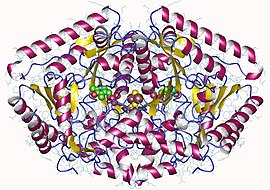In enzymology, 4-aminobutyrate transaminase (EC 2.6.1.19), also called GABA transaminase or 4-aminobutyrate aminotransferase, or GABA-T, is an enzyme that catalyzes the chemical reaction:
| 4-aminobutyrate transaminase | |||||||||
|---|---|---|---|---|---|---|---|---|---|
 4-Aminobutyrate transaminase homodimer, Pig | |||||||||
| Identifiers | |||||||||
| EC no. | 2.6.1.19 | ||||||||
| CAS no. | 9037-67-6 | ||||||||
| Databases | |||||||||
| IntEnz | IntEnz view | ||||||||
| BRENDA | BRENDA entry | ||||||||
| ExPASy | NiceZyme view | ||||||||
| KEGG | KEGG entry | ||||||||
| MetaCyc | metabolic pathway | ||||||||
| PRIAM | profile | ||||||||
| PDB structures | RCSB PDB PDBe PDBsum | ||||||||
| Gene Ontology | AmiGO / QuickGO | ||||||||
| |||||||||
| 4-aminobutyrate transaminase | |||||||
|---|---|---|---|---|---|---|---|
| Identifiers | |||||||
| Symbol | ABAT | ||||||
| NCBI gene | 18 | ||||||
| HGNC | 23 | ||||||
| OMIM | 137150 | ||||||
| RefSeq | NM_020686 | ||||||
| UniProt | P80404 | ||||||
| Other data | |||||||
| Locus | Chr. 16 p13.2 | ||||||
| |||||||
- 4-aminobutanoate + 2-oxoglutarate succinate semialdehyde + L-glutamate
Thus, the two substrates of this enzyme are 4-aminobutanoate (GABA) and 2-oxoglutarate. The two products are succinate semialdehyde and L-glutamate.
This enzyme belongs to the family of transferases, specifically the transaminases, which transfer nitrogenous groups. The systematic name of this enzyme class is 4-aminobutanoate:2-oxoglutarate aminotransferase. This enzyme participates in 5 metabolic pathways: alanine and aspartate metabolism, glutamate metabolism, beta-alanine metabolism, propanoate metabolism, and butanoate metabolism. It employs one cofactor, pyridoxal phosphate.
This enzyme is found in prokaryotes, plants, fungi, and animals (including humans).[1] Pigs have often been used when studying how this protein may work in humans.[2]
Enzyme Commission number
GABA-T is Enzyme Commission number 2.6.1.19. This means that it is in the transferase class of enzymes, the nitrogenous transferase sub-class and the transaminase sub-subclass.[3] As a nitrogenous transferase, its role is to transfer nitrogenous groups from one molecule to another. As a transaminase, GABA-T's role is to move functional groups from an amino acid and a α-keto acid, and vice versa. In the case of GABA-T, it takes a nitrogen group from GABA and uses it to create L-glutamate.
Reaction pathway
In animals, fungi, and bacteria, GABA-T helps facilitate a reaction that moves an amine group from GABA to 2-oxoglutarate, and a ketone group from 2-oxoglutarate to GABA.[4][5][6] This produces succinate semialdehyde and L-glutamate.[4] In plants, pyruvate and glyoxylate can be used in the place of 2-oxoglutarate.[7] catalyzed by the enzyme 4-aminobutyrate—pyruvate transaminase:
- (1) 4-aminobutanoate (GABA) + pyruvate ⇌ succinate semialdehyde + L-alanine
- (2) 4-aminobutanoate (GABA) + glyoxylate ⇌ succinate semialdehyde + glycine
Cellular and metabolic role
The primary role of GABA-T is to break down GABA as part of the GABA-Shunt.[2] In the next step of the shunt, the semialdehyde produced by GABA-T will be oxidized to succinic acid by succinate-semialdehyde dehydrogenase, resulting in succinate. This succinate will then enter mitochondrion and become part of the citric acid cycle.[8] The critic acid cycle can then produce 2-oxoglutarate, which can be used to make glutamate, which can in turn be made into GABA, continuing the cycle.[8]
GABA is a very important neurotransmitter in animal brains, and a low concentration of GABA in mammalian brains has been linked to several neurological disorders, including Alzheimer's disease and Parkinson's disease.[9][10] Because GABA-T degrades GABA, the inhibition of this enzyme has been the target of many medical studies.[9] The goal of these studies is to find a way to inhibit GABA-T activity, which would reduce the rate that GABA and 2-oxoglutarate are converted to semialdehyde and L-glutamate, thus raising GABA concentration in the brain. There is also a genetic disorder in humans which can lead to a deficiency in GABA-T. This can lead to developmental impairment or mortality in extreme cases.[11]
In plants, GABA can be produced as a stress response.[5] Plants also use GABA to for internal signaling and for interactions with other organisms near the plant.[5] In all of these intra-plant pathways, GABA-T will take on the role of degrading GABA. It has also been demonstrated that the succinate produced in the GABA shunt makes up a significant proportion of the succinate needed by the mitochondrion.[12]
In fungi, the breakdown of GABA in the GABA shunt is key in ensuring a high level of activity in the critic acid cycle.[13] There is also experimental evidence that the breakdown of GABA by GABA-T plays a role in managing oxidative stress in fungi.[13]
Structural Studies
There have been several structures solved for this class of enzymes, given PDB accession codes, and published in peer-reviewed journals. At least 4 such structures have been solved using pig enzymes: 1OHV, 1OHW, 1OHY, 1SF2, and at least 4 such structures have been solved in Escherichia coli: 1SFF, 1SZK, 1SZS, 1SZU. There are actually some differences between the enzyme structure for these organisms. E. coli enzymes of GABA-T lack an iron-sulfur cluster that is found in the pig model.[14]
Active sites
Amino acid residues found in the active site of 4-aminobutyrate transaminase include Lys-329, which are found on each of the two subunits of the enzyme.[15] This site will also bind with a pyridoxal 5'- phosphate co-enzyme.[15]
Inhibitors
References
Further reading
External links

- 4-Aminobutyrate+Transaminase at the U.S. National Library of Medicine Medical Subject Headings (MeSH)
- Pearl PL, Parviz M, Hodgeman R, Gibson KM, Reimschisel T (2015). "GABA-transaminase deficiency". MedLink Neurology.

